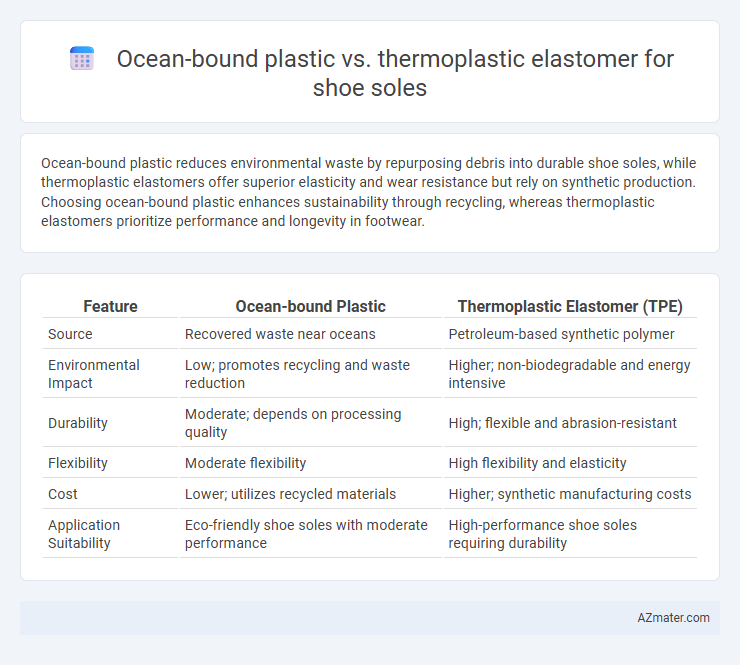Ocean-bound plastic reduces environmental waste by repurposing debris into durable shoe soles, while thermoplastic elastomers offer superior elasticity and wear resistance but rely on synthetic production. Choosing ocean-bound plastic enhances sustainability through recycling, whereas thermoplastic elastomers prioritize performance and longevity in footwear.
Table of Comparison
| Feature | Ocean-bound Plastic | Thermoplastic Elastomer (TPE) |
|---|---|---|
| Source | Recovered waste near oceans | Petroleum-based synthetic polymer |
| Environmental Impact | Low; promotes recycling and waste reduction | Higher; non-biodegradable and energy intensive |
| Durability | Moderate; depends on processing quality | High; flexible and abrasion-resistant |
| Flexibility | Moderate flexibility | High flexibility and elasticity |
| Cost | Lower; utilizes recycled materials | Higher; synthetic manufacturing costs |
| Application Suitability | Eco-friendly shoe soles with moderate performance | High-performance shoe soles requiring durability |
Understanding Ocean-Bound Plastic: Definition and Sources
Ocean-bound plastic refers to waste materials found within 50 kilometers of coastlines, primarily originating from improperly managed land-based sources such as rivers, beaches, and urban runoff. These plastics often include common items like packaging, fishing gear, and everyday single-use products, which contribute significantly to marine pollution before breaking down into microplastics. Understanding the types and sources of ocean-bound plastics is crucial for developing sustainable alternatives like thermoplastic elastomers, which offer durability and recyclability in shoe sole manufacturing.
What are Thermoplastic Elastomers (TPE) in Footwear?
Thermoplastic Elastomers (TPE) in footwear are versatile materials combining the elasticity of rubber with the processing advantages of plastics, making them ideal for shoe soles due to their durability, flexibility, and recyclability. Unlike ocean-bound plastic, which is repurposed waste material collected near coastal environments, TPE is engineered from polymers designed to provide consistent performance, cushioning, and resistance to wear. Their ability to be molded and remolded multiple times without losing properties offers a sustainable alternative in footwear manufacturing focused on high-quality and long-lasting soles.
Environmental Impact: Ocean-Bound Plastic vs TPE
Ocean-bound plastic repurposes waste destined for oceans, significantly reducing marine pollution and conserving aquatic ecosystems, while thermoplastic elastomers (TPE) rely on petrochemical sources with higher carbon footprints. The use of ocean-bound plastics lowers landfill accumulation and promotes circular economy practices, whereas TPE production involves energy-intensive processes and potential environmental toxins. Choosing ocean-bound plastic for shoe soles aligns with sustainability goals by minimizing ocean pollution and fostering waste recovery, compared to the conventional environmental impacts associated with TPE manufacturing.
Material Properties: Flexibility, Durability, and Comfort
Ocean-bound plastic offers moderate flexibility and durability but often requires blending with other materials to enhance softness and long-term wear resistance. Thermoplastic elastomers (TPE) provide superior flexibility and excellent durability due to their elastic properties, ensuring better shock absorption and comfort in shoe soles. While ocean-bound plastic contributes to sustainability, TPE outperforms in comfort and performance for prolonged use.
Manufacturing Processes and Energy Consumption
Ocean-bound plastic used for shoe soles undergoes a recycling and cleaning process that requires lower energy input compared to the high-temperature molding and extrusion needed for thermoplastic elastomers (TPE). Thermoplastic elastomers demand energy-intensive compounding and heating cycles to achieve durability and flexibility, contributing to a higher carbon footprint during manufacturing. Utilizing ocean-bound plastic reduces reliance on virgin polymers and typically results in lower overall energy consumption due to simplified processing steps.
Performance Comparison for Shoe Soles
Ocean-bound plastic offers sustainability benefits by utilizing waste materials, but thermoplastic elastomers (TPE) provide superior flexibility, durability, and abrasion resistance essential for high-performance shoe soles. TPEs maintain excellent elasticity and impact absorption, extending shoe lifespan and enhancing wearer comfort, while ocean-bound plastic composites may face limitations in consistency and mechanical properties. Selecting TPE ensures reliable performance under varying environmental conditions, whereas ocean-bound plastics contribute primarily to eco-friendly innovation without fully matching TPE's functional advantages in sole performance.
Recyclability and End-of-Life Options
Ocean-bound plastic for shoe soles offers a sustainable solution by repurposing waste materials that would otherwise pollute marine environments, enhancing recyclability through established ocean-plastic recycling streams. Thermoplastic elastomers (TPE) provide excellent recyclability due to their ability to be repeatedly melted and reshaped, facilitating efficient circular economy practices. End-of-life options for ocean-bound plastic soles rely on mechanical recycling systems, while TPE soles can be chemically recycled or ground into granules for reuse in new sole production, promoting reduced landfill dependency.
Cost Analysis: Production and Market Price
Ocean-bound plastic reduces raw material costs in shoe sole production by utilizing recycled waste with a lower input price compared to virgin thermoplastic elastomers (TPEs). Thermoplastic elastomers offer consistent quality and performance but generally incur higher production expenses due to petrochemical sourcing and processing complexity. Market prices for ocean-bound plastic soles often reflect eco-friendly premiums, while TPE soles command stability in cost driven by advanced manufacturing and material durability.
Sustainability in Footwear: Consumer Preferences
Ocean-bound plastic and thermoplastic elastomers (TPE) represent two distinct materials for sustainable shoe soles, with ocean-bound plastic appealing to eco-conscious consumers due to its role in reducing marine pollution by repurposing waste collected near coastlines. Thermoplastic elastomers offer durability, flexibility, and recyclability, attracting preferences focused on product longevity and circular economy principles. Consumer trends increasingly favor ocean-bound plastics for their positive environmental impact, while TPEs meet demands for performance and recyclability, reflecting a nuanced balance in sustainability priorities within footwear choices.
Future Trends: Innovations in Sustainable Shoe Soles
Future trends in sustainable shoe soles emphasize the innovative use of ocean-bound plastic, which reduces marine pollution by repurposing recovered waste into durable materials for footwear. Thermoplastic elastomers (TPEs) are gaining traction due to their recyclability, flexibility, and ability to be engineered from bio-based or recycled feedstocks, enhancing the environmental profile of shoe soles. Combining ocean-bound plastics with advanced TPE formulations offers a promising pathway for creating high-performance, eco-friendly soles that align with circular economy principles.

Infographic: Ocean-bound plastic vs Thermoplastic elastomer for Shoe sole
 azmater.com
azmater.com